Can You Freeze Breadcrumbs
Yes, you can freeze breadcrumbs, and it's an excellent way to extend their shelf life and reduce food waste. Frozen breadcrumbs maintain their quality for up to three months when stored in an airtight container. You can use them directly from the freezer in many recipes, though they may require higher cooking temperatures for ideal crispiness. To prevent sogginess, consider drying the breadcrumbs before freezing. This process reduces moisture content and minimizes ice crystal formation. Whether you're making homemade breadcrumbs or storing store-bought ones, freezing offers a convenient and cost-effective solution for keeping them fresh. The versatility of frozen breadcrumbs extends beyond simple coatings, offering numerous culinary possibilities.
This post may contain affiliate links. If you make a purchase through these links, I may earn a commission at no additional cost to you. Additionally, portions of this post may be generated using artificial intelligence (AI) technology. While we strive for accuracy, please be aware that AI-generated content may not always be perfect and should be fact-checked when necessary.
The Spatula Scoops
- Breadcrumbs can be frozen for up to 3 months, extending their shelf life and reducing food waste.
- Freezing breadcrumbs is convenient, providing instant availability for various recipes and coatings.
- Proper storage in airtight containers minimizes moisture and preserves freshness during freezing.
- Drying breadcrumbs before freezing enhances their quality and reduces ice crystal formation.
- Frozen breadcrumbs can be used directly from the freezer, though thawing may be necessary for certain recipes.
Benefits of Freezing Breadcrumbs
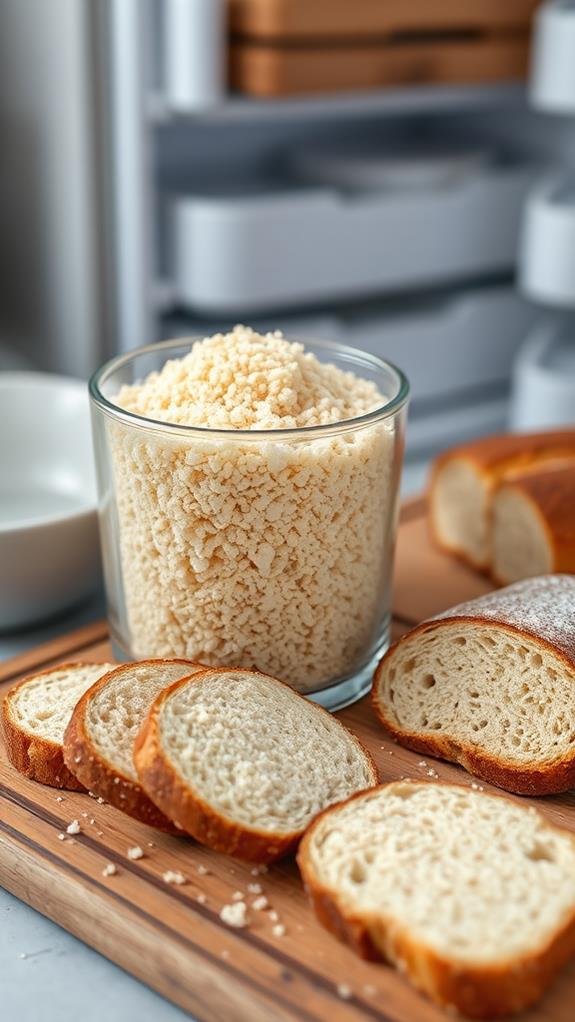
When it comes to kitchen efficiency, freezing breadcrumbs offers several advantages. You'll find that this simple practice can considerably reduce food waste while guaranteeing you always have a key ingredient on hand. By repurposing stale bread into frozen breadcrumbs, you're not only saving money but also minimizing what ends up in your trash bin.
One of the primary benefits is the extended shelf life. While store-bought breadcrumbs might last a few months in your pantry, frozen breadcrumbs can maintain their quality for up to three months in the freezer. This longevity means you'll always have a supply ready for your culinary needs, whether it's for coating chicken, topping casseroles, or adding texture to meatballs.
Convenience is another key advantage. When you freeze breadcrumbs, you're fundamentally creating your own instant ingredient. You can use them directly from the freezer in many recipes, though thawing may improve their texture in some applications. To maximize their usefulness, store them in airtight bags and label them with dates. This way, you'll always know how long they've been frozen and can ensure you're using the freshest breadcrumbs possible in your cooking.
Cooking From Frozen
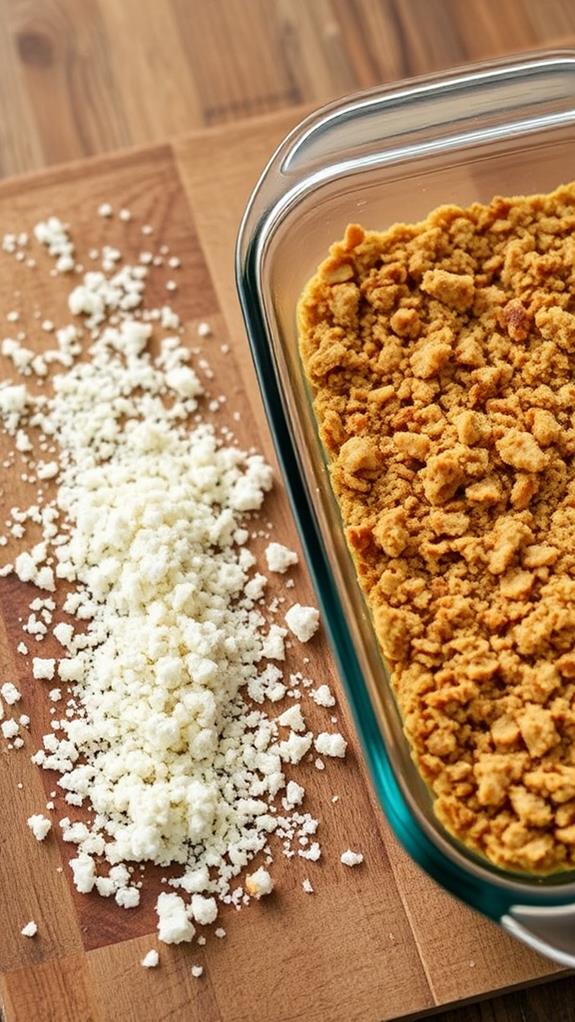
Convenience reigns supreme when cooking with frozen breadcrumbs. You can use them straight from the freezer, saving precious time during meal prep. However, it's crucial to be aware of potential challenges and adapt your cooking methods accordingly.
When using frozen breadcrumbs, you might notice ice crystals forming on the surface. These can lead to sogginess in your final dish if not addressed. To combat this, consider adjusting your cooking techniques. For frying, you may need to increase the heat slightly or cook for a bit longer to achieve that desirable crispy texture.
For best results, try thawing your breadcrumbs overnight on a baking sheet. This method guarantees even thawing and helps maintain their crispness when cooked. If you're planning ahead, drying the breadcrumbs before freezing can greatly improve their texture when used directly from frozen.
Thawing Techniques
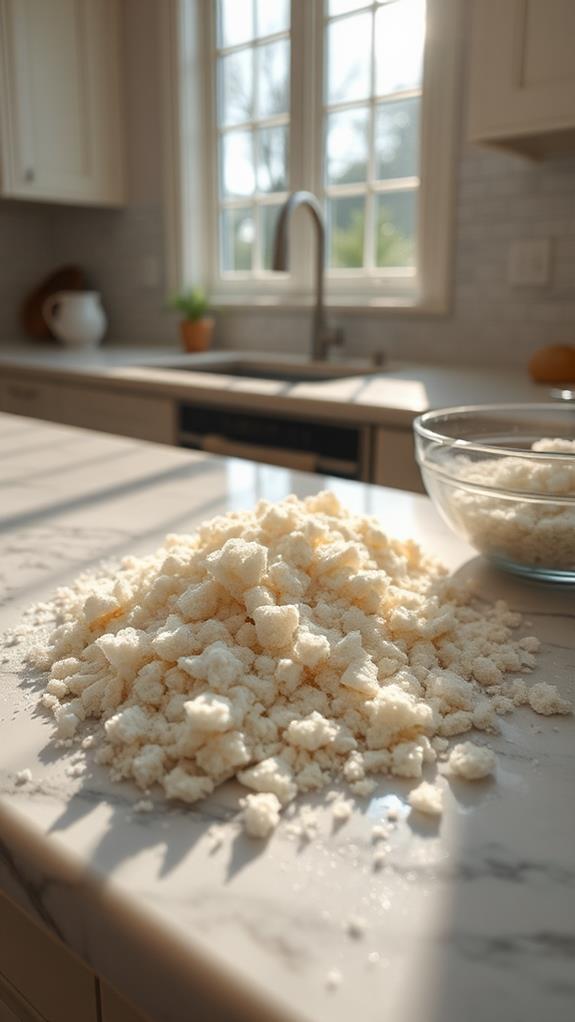
When it's time to thaw your frozen breadcrumbs, you've got two main options: the overnight refrigeration method and the quick-thaw room temperature technique. The overnight method involves spreading your breadcrumbs on a baking sheet and letting them thaw slowly in the fridge, which helps maintain their texture and prevents sogginess. For a faster approach, you can spread the breadcrumbs thinly on a countertop and let them come to room temperature, though you'll need to keep an eye on them to make sure they don't absorb excess moisture.
Overnight Refrigeration Method
Thawing frozen breadcrumbs doesn't have to be a hassle. The overnight refrigeration method is a simple and effective way to defrost your breadcrumbs while maintaining their quality. To begin, remove your frozen breadcrumbs from the freezer and spread them evenly on a baking sheet. This distribution guarantees uniform cooling and moisture dispersal throughout the thawing process.
Place the baking sheet in your refrigerator and leave it overnight. This gentle thawing technique helps preserve the texture and quality of your breadcrumbs. Once thawed, you can use them immediately or take an extra step to enhance their crispness. If you prefer a crunchier texture, you can place the thawed breadcrumbs in a low-temperature oven for a brief period to dry them out slightly.
Quick-Thaw Room Temperature Technique
For those times when you need breadcrumbs in a hurry, the quick-thaw room temperature technique offers a speedy solution. To thaw breadcrumbs quickly, spread them out in a single layer on a baking sheet. This method guarantees even thawing and prevents moisture buildup, which can lead to soggy breadcrumbs.
Leave your frozen breadcrumbs exposed to air for 15-30 minutes, depending on the quantity. This allows them to reach a suitable temperature for cooking. It's vital not to pile the breadcrumbs, as this can create pockets of moisture and affect their texture. If you notice any icy patches after thawing, you can pop them in a low-temperature oven for a few minutes to dry out and enhance their crispness.
Drying Before Freezing
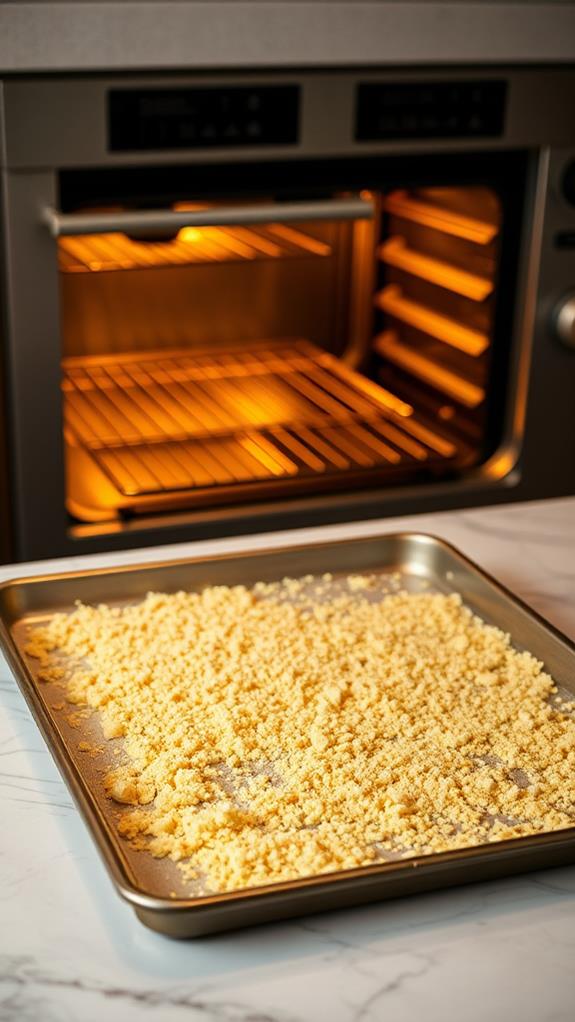
You'll want to contemplate drying your breadcrumbs before freezing to enhance their quality and usability. Reducing moisture content through techniques like spreading them in a warm, dry area or using low oven heat can markedly improve their texture when frozen. By incorporating this drying step, you're ensuring that your breadcrumbs remain crisp and ice crystal-free, which will result in better performance in recipes after thawing.
Moisture Reduction Techniques
Before freezing breadcrumbs, it's vital to reduce their moisture content. This step is significant for guaranteeing properly dried breadcrumbs that are suitable for long-term storage. You've got two main options to achieve this: air-drying and oven-drying.
For air-drying, spread your breadcrumbs in a warm, dry area for 1-2 hours. This method is simple but effective, allowing excess moisture to evaporate naturally. If you're short on time or want a more thorough approach, try oven-drying. Set your oven to a low temperature of 300°F (150°C) and spread the breadcrumbs on a baking sheet. Leave them in for 30-60 minutes, stirring occasionally to maintain even drying. This technique is particularly effective at reducing moisture content.
Why is moisture reduction so important? When breadcrumbs contain excess moisture, they're prone to forming ice crystals during freezing. This can negatively impact their texture and quality. By properly drying your breadcrumbs before freezing, you're preserving their crispiness and making sure they'll be ready to use in your favorite recipes whenever you need them.
Texture Preservation Methods
Preserving the texture of your breadcrumbs is vital for maintaining their quality during freezing. To achieve this, you'll want to focus on drying them thoroughly before placing them in the freezer. This process considerably enhances their texture, guaranteeing they remain crispy when you cook with them later.
To dry your breadcrumbs effectively, spread them out in a warm, dry area or use a low-temperature oven set at 300°F (150°C) for 30 to 60 minutes. During this time, stir the breadcrumbs occasionally to prevent clumping and confirm even moisture removal. This step is important for texture preservation, as it reduces the moisture content that can lead to ice crystal formation during freezing.
Alternative Uses and Tips

Ever wondered how versatile breadcrumbs can be? Once you make breadcrumbs, you'll never throw them away again. They're not just for coating fried foods; you can use them in numerous creative ways to enhance your culinary creations.
Sprinkle breadcrumbs over casseroles and pasta dishes to add a delightful crunch and improve texture. They're also excellent binders for meatballs and meatloaf, helping to retain moisture and prevent the mixture from falling apart. For a nutritious twist, mix breadcrumbs with chopped nuts or seeds to create a crunchy coating for baked or fried proteins.
Don't forget to season your breadcrumbs. Adding fresh herbs, garlic, or cheese can elevate their flavor profile, making them suitable for various recipes. You can even use seasoned breadcrumbs as a substitute for traditional stuffing in poultry or vegetable roasts, giving classic dishes a unique spin.
Homemade vs. Store-Bought Options
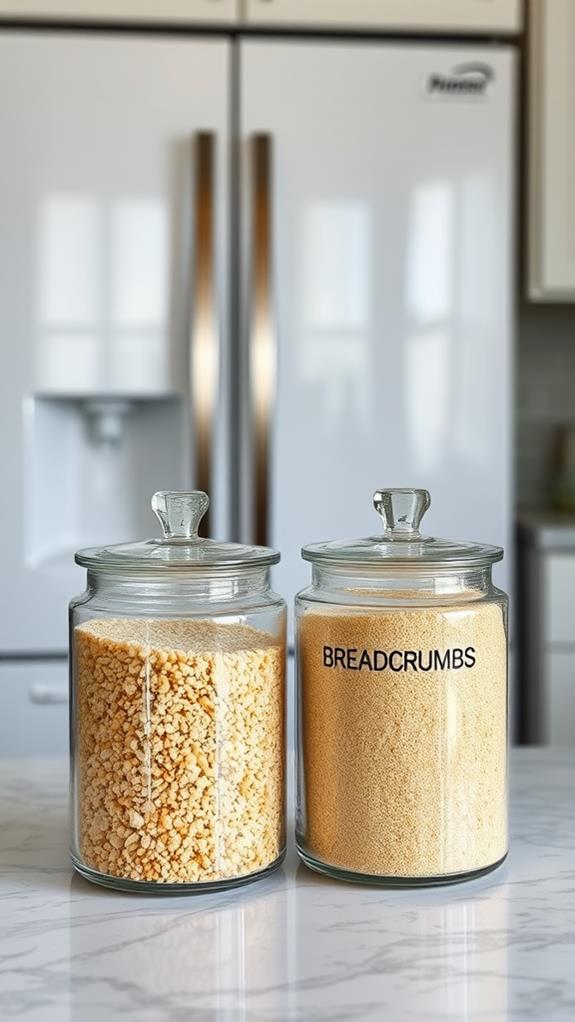
Now that we've explored creative uses for breadcrumbs, let's consider the choice between homemade and store-bought options. When it comes to freezing breadcrumbs, homemade versions offer several advantages. You can easily freeze homemade breadcrumbs for up to three months in a sealed plastic bag without compromising quality, making them a cost-effective alternative to store-bought options. Additionally, you'll avoid the preservatives and additives often found in commercial products, resulting in a healthier choice.
Homemade breadcrumbs also allow for customization. You can add herbs, spices, or cheese before freezing, creating unique flavors not typically available in store-bought varieties. For the best results, use stale bread to enhance flavor and texture. While both types can be used directly from the freezer, homemade breadcrumbs may require slight drying for ideal texture.
Store-bought breadcrumbs, on the other hand, maintain a consistent quality and texture due to mass production. They're convenient and ready to use straight from the package or freezer. However, you'll sacrifice the ability to control ingredients and customize flavors. Ultimately, the choice between homemade and store-bought breadcrumbs depends on your priorities: convenience versus customization and control over ingredients.
Frequently Asked Questions
Do You Need to Defrost Frozen Breadcrumbs?
You don't necessarily need to defrost frozen breadcrumbs. They can be used directly from the freezer, making them convenient for last-minute cooking. However, if you prefer, you can thaw them overnight on a baking sheet for even defrosting. Keep in mind that once thawed, breadcrumbs should be used within a few days and shouldn't be refrozen. If you notice ice crystals on frozen breadcrumbs, consider drying them in a low oven to restore crispness before use.
How to Use Frozen Bread Crumbs?
"Waste not, want not" applies perfectly to frozen breadcrumbs. You can use them straight from the freezer in many recipes. For frying, dry them in a low oven first to prevent sogginess. When making meatloaf or casseroles, mix the frozen crumbs with seasonings just before use. Take out only what you need, saving time and reducing waste. Remember to check for freezer burn and use within three months for the best quality. Frozen breadcrumbs are a convenient pantry staple for quick meal prep.
How to Store Bread Crumbs Long Term?
To store breadcrumbs long term, you'll want to focus on keeping them dry and protected from air. Use airtight containers or sealable plastic bags, and be sure to label and date them. For extended storage, consider freezing in portioned sizes or vacuum-sealing to prevent freezer burn. Regularly check for any signs of spoilage. When stored properly, breadcrumbs can last up to 3 months in the pantry or even longer in the freezer. Remember, proper storage guarantees peak freshness and quality.
Can I Freeze Panko Breadcrumbs?
Yes, you can freeze panko breadcrumbs easily and effectively. They're excellent for freezing, as they maintain their texture and flavor for up to three months when stored properly. To freeze panko, make sure they're completely cool, then place them in an airtight container or sealable plastic bag. Label and date the container for easy tracking. You'll find that frozen panko can be used straight from the freezer without thawing, making it convenient for quick meal prep. Just be mindful that they may brown faster when cooking.
Conclusion
You've now got the lowdown on freezing breadcrumbs, a culinary technique that's as handy as a pocket on a shirt. Remember, whether you're using homemade or store-bought crumbs, proper storage is key. By freezing, you'll extend their shelf life and always have them ready for your next culinary creation. Don't forget to dry them thoroughly before freezing, and you'll be set for crispy coatings, flavorful toppings, and more. With these tips, you're ready to make the most of your breadcrumbs.





